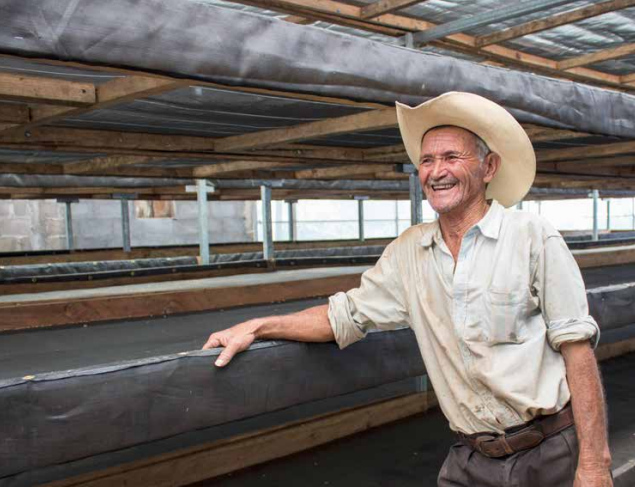
Coffee is sold at a price that has nothing to do with farmers’ living expenses. When the C price fell to a 12-year low in August, it prompted heated discussion about how coffee pricing works and its impact on producers.
Is it reasonable that coffee is used as a financial investment at the expense of producers? Some are arguing that the C price is an ineffective way of handling coffee pricing and calling for a new model.
But what are the problems with the C price? Is it time for a new financial structure in the coffee industry? And is it possible to have truly equitable prices for producers?
What Is The C Price?
The price of coffee changes every minute. This is because it is handled as a commodity. Commodities are simply raw materials that can be bought and sold on regulated markets known as commodities exchanges.
The Intercontinental Exchange (ICE) is a major commodities exchange based in New York City. The trading price of Arabica on the ICE is known as the C price, and it is this figure that affects the price of coffee. All coffee is treated as one raw material, regardless of origin or other factors. Even specialty coffee prices are usually linked to the C price, plus a premium.
At its basic level, the C price is defined by supply and demand. That is, the price sits at the point at which supply equals demand. If there is a scarcity of coffee, the price will go up until people decide not to buy because it is too high.
If there’s a lot of coffee available, the price will fall to make it more appealing to buy. As the price drops, people buy more to take advantage of a good deal. The price stops dropping at the point where buyers collectively agree to buy the quantity available. Theoretically, the demand for coffee determines how expensive it is.
Commodities are traded on the balance of supply and demand and the market directly reflects how much coffee is available and how much people want it. Or at least, that is how it is supposed to work.

How The C Price Really Works
The seemingly straightforward system of supply and demand is not the reality of the C price. Let’s take a look at how the financial market affects supply and demand.
Futures contracts are essentially promises to purchase coffee at a future date at a price determined today. The agreed-upon price in a futures contract is based on the predicted price at delivery date. So a lot of the price is determined by speculation.
For example, if people think the C price will increase in the future due to a weak harvest, they’ll start buying futures contracts today to sell for a profit when the price increases closer to the delivery date. The increased demand for coffee contracts now, based on speculation about future conditions, causes the current price to go up.
The reverse is also true. If there is speculation that the price will drop, people will start selling coffee and any futures contracts. This will cause the current price to drop.
What this means is that the price of coffee is removed from real market conditions. The C price is not linked to the cost of production, and this has a very real impact on producers.
Is the C Price a Broken System?
Karl Wienhold handles logistics and marketing at Direct Origin Trading. Before focusing on coffee, he was an international trade consultant and rural development economist. He is also the author of an upcoming book on the economics of the coffee supply chain.
Karl tells me that “the ‘C market’ is a well-intended system created with the goal of bringing efficiency to globally traded coffee and offering protection mechanisms to supply chain actors.”
But he says that this is not how the model works today. “The result has been some protection for traders with means, and “the C market” has been hijacked by hedge funds and other speculators, causing wild swings that are disproportionate to supply-demand movements,” he says.
Some investors speculate on coffee without ever intending to use it. Others speculate to increase the profit margins of their roastery or export business. Karl tells me that this use of coffee as a financial tool has an unfair impact on producers.
“This has left unhedged smallholder farmers to bear the brunt while the rest of the supply chain enjoys healthy margins,” he says. “Today, amid market volatility, farmers speculate and let coffee fade, take losses, and go deep into debt hoping for an uptick. When there is a windfall, they are less likely to invest in the next year’s crop, unsure whether it will be sold for a loss.”

How The C Price Affects Producers
A farmer’s production costs have nothing to do with C price fluctuations, and producers usually have very small profit margins. So when the C price dips, it can very easily put a farmer in the red. This even applies to those selling at a rate that’s a significant percentage premium above the C price.
Evelio Francisco Alvarado Romero is a general manager at Anacafe. He tells me that the recent drop in price means that producers can’t afford to invest in their farms and that this will have long-term impacts.
“Since the beginning of the year, speculators have been heavy sellers in the agriculture sector, betting for lower prices because of uncertainty with US/China tariffs and record crops in Brazil. But speculators are not taking into account higher producing costs, like coffee that is below producing costs. This is forcing countries to devalue their coffee to compensate for price decline.”
He continues, “In the coffee industry speculators selling side contracts reached an all-time record of 106,000 contracts last August, almost 35% of total open interest. Producers are not taking proper care of plantations and eventually the industry will face higher prices because of production decline.”
Marta Dalton, the founder and CEO of Coffee Bird, says that producers are at breaking point.
“The current coffee market prices are exceptionally low. The prices are below the cost of production and threaten the livelihood of many families who rely on the C price to sell their coffee for subsistence,” she tells me.
“The majority of farmers rely on the C price. The exception is the small group of farmers with market access who manage to trade their coffee with a fixed price. The coffee industry is at a breaking point. Already many farmers are selling their farms or abandoning parts of their farm. If we want to see coffee in Guatemala and other Latin American countries around in the future we need a new pricing mechanism that reflects actual costs and is independent of outside forces.”
Producers Want a New Pricing Model
On September 30th, the World Coffee Producers Forum (WCPF) sent an open letter to the CEOs of major coffee companies.
It states: “Some may argue that ‘the market is the market and it does what it has to do’. For some products, that may be the case. However, in the case of coffee, where you have the livelihood of more than 25 million families at stake, many of which are facing a pauperization process that is taking them to a situation of misery, that is nothing short of inhumane.”
This comes after a September 17th ICO meeting in London, at which the WCPF held a press conference. The WCPF said that it hoped the ICO meeting would focus on low prices.
They released a statement that includes: “Coffee producers all over the world are facing its worst situation in decades due to the crisis and generated by the extremely low international prices. Today, the imbalance in the coffee value chain and the process of pauperization of the coffee producers are at levels that we do not hesitate to define as tragic.”

How The C Price Affects Producers
But what would an alternative pricing model look like? Karl suggests one that is linked to real costs and based on greater transparency.
“Multi-year fixed-price contracts operated from farm to roaster would de-risk much of coffee production and sourcing without the need for hedging instruments. Personal trust and transparency are fundamental to these contracts holding up. This kind of operation was impossible several decades ago, but with today’s technology, traceability protocols, and ease of travel and communication, it’s a viable option in many segments of the industry,” he says.
“The downside is that with fixed supply agreements in place, roasters cannot take advantage of low prices to widen margins, and farmers must abstain if the local price floats higher than their contracted price.”
The call for minimum pricing is not simply a reaction to this year’s dropping prices. At the World Coffee Producers’ Forum 2017, the topic dominated discussion. But it can be a polarising subject. Some, including Karl, have wondered whether removing market forces would lead to a flooded market in which farmers can’t sell their coffee at all.
Karl argues that rather than a blanket minimum price, fair pricing has to be linked to the real cost of production, which varies across different countries, and that the emphasis needs to be placed on transparency.
He says that “while most smallholder farmers only look at price, their economic sustainability has more to do with production cost and price stability. Paying them a generous differential, say US 30 cents per pound, and gloating in a CSR report about it, loses meaning when production costs are 40 cents per pound over current base price.”
“Farmers’ inputs do not depend on the C price,” he continues. “Consumers do not purchase flat whites and bags of whole-bean coffee based on the C price. If roasters were to insist on fixed pricing to farmers, signing fixed contracts with their importers, and if importers were able to verify payments to producers, it would be feasible to simply bypass the futures market and offer farmers a fixed portion of the roaster price.”
There is no easy fix to the unstable price of coffee and the devastating impact the current system has on producers. Simply implementing a minimum price is a short-term idea rather than a genuine solution.
But by increasing transparency, consumers can become more aware of where their coffee comes from and the human impact of commodity trading.
Perhaps it is time for the industry to stop debating and start making concrete changes to improve transparency and link the cost of coffee to the real cost of production.









NO COMMENT